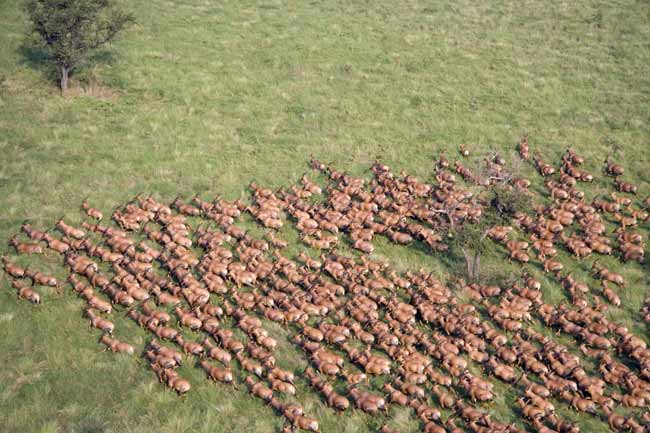Migration of large mammals is gradually disappearing
Africa is known as the place where spectacular animal migration takes place. Large mammal species, from antelope gaze to wildebeest green species (mammals and large abdomen, and the combination of antelope and horse) ND clawed on large areas of land whenever transfer season.
However, the new study shows that migration on this continent will gradually disappear.
For the first time, scientists collected and analyzed data on migratory large mammal species worldwide. The researchers looked at the migration history of a group of ungulates, all of which are mammalian ungulate with a body weight of more than 44 pounds (20 kg). Data show that 1/4 of these species are now no longer migratory, and the development of modern human life is the cause of change - citing researcher Grant Harris.
In many cases, even data about these animals do not exist.
'I thought,' Oh my God, there is nothing left here, 'and if there is nothing left for these big mammals, it means there is no more left for other species, ' Harris told LiveScience reporter.

Tiang horned antelope in the southern region of Boma National Forest.(Photo: P. Elkan, Wildlife Conservation / National Geographic Association)
Harris, a conservation biologist, conducted the study in collaboration with the Center for Conservation and Biodiversity of the American Museum of Natural History in New York. He is now a member of the US Department of Fish and Wildlife Protection. The report of the study results is published in Endangered Species Research in April.
The known thing
Large mammals such as wildebeest or bison live on fresh plants such as grass. They live in large flocks, so the source of food in a fixed position cannot be enough for the whole herd, and where there is rain or snow melts, the seedlings thrive, the herd will follow the trail of that richness. But it is difficult to predict when and where this phenomenon is occurring, so the migrations rarely follow a repeating path , in many cases even experienced researchers are unlikely to have predictable.

Elephants in Sudd swamps.(Photo: P. Elkan, Wildlife Conservation / National Geographic Association)
To better understand the current status of animal migration, Harris and his colleagues focused on the number of populations, migration history and threats to 24 migratory habitat species. - of which 14 species in Africa, 7 species in Eurasia and 4 species in North America (Rangifer tarandus reindeer is present both in Eurasia and North America).
Researchers have discovered that in 6 of these 24 species - South African antelope springbok, wildebeest black, South African blesbok, cheated kulan forest, scimitar oryx (scimitar horned oryx) and plain zebra ( guagga - extinct) - now mass migration no longer exists, or their current status is not defined, or even extinct completely.
Africa is home to 5 of the 6 animals mentioned above.
What is the problem?
Most populations lack basic data, such as number of herds, distance or migration route. At the same time, a lot of data is available, the old numbers were obtained from dozens of years ago. This new study provides an action framework for future conservation efforts as scientists overcome data gaps and map out strategies to protect migrations, Stuart Pimm , a Duke biologist, who is not involved in the study, commented.

African antelope, Boma National Forest.(Photo: P. Elkan, Wildlife Conservation / National Geographic Association)
In previous studies, a series of threats have been listed for 20 herds of migratory species.Hunting is listed as a threat to 17 species . Most of these animals migrate across the boundaries of a protected area or a country, human fences and paths that can prevent them from accessing food and drinking water. Some conservationists agree to include these species in protected areas, but often the migratory roads will cross the borders of the reserve, the development of agricultural production and many other areas of humans. The surrounding area can make migratory species inaccessible to food and water. Protected areas themselves are also fenced, which confines animals and hinders their migration.
There is no one-size-fits-all solution to protect migration, Pimm said. Currently we still do not have the necessary studies for the animals themselves, let alone their migration. But most scientists argue that if you find all the necessary data on immigration before finding a way to help wildlife, then it is too late.
But according to Pimm, 'you can't think of solutions when you don't even know all the problems that are being raised.'
- Great extinct Australian mammals
- Spam 'get rich' for recipients
- Wonders are gradually disappearing
- 200 years later, the largest terrestrial mammal could be cattle
- Taiwan gorge suddenly appeared, disappearing fast record
- Archaeological discovery of venomous mammals on hind legs
- Zebras record the longest migration on the continent
- Gray whales with a record long migration distance of 10.880 km
- African deserts gradually disappear, lions are threatened
- Why are human breasts big?
- Changes in sea conditions in Sargasso affect eel fishing
- Why does dog like gnawing the bone?
 Animal 'suffering' after hibernation
Animal 'suffering' after hibernation Why do goats climb well?
Why do goats climb well? Scientists were surprised to see chimpanzees eating turtles
Scientists were surprised to see chimpanzees eating turtles Giant catfish died deadly due to drought in Thailand
Giant catfish died deadly due to drought in Thailand